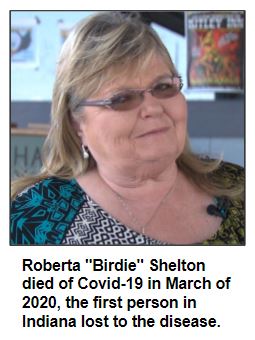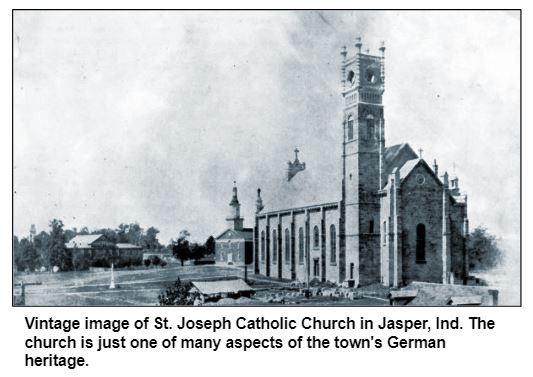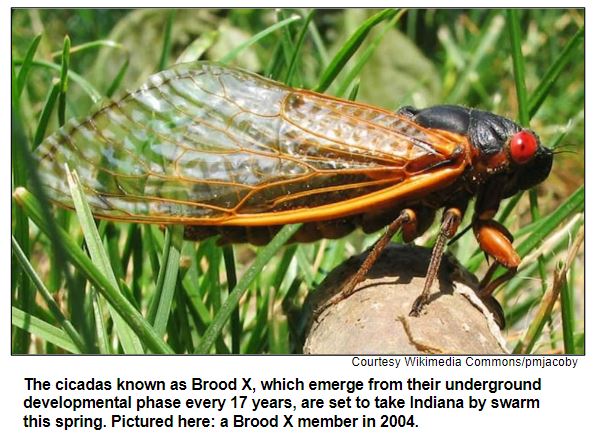Saturdays, noon to 1 p.m. ET on WICR 88.7 FM.
Or stream audio live from anywhere on WICR Online!
April 24, 2021
Covid history in Indiana

During this show, we also will compare the spread in urban and rural areas, describe early challenges in contact tracing and explore other aspects of the emerging epidemic. Nelson will be joined by a journalist who has covered the impact of Covid-19 in Indiana since it entered public awareness.
Shari Rudavsky, the health and medical reporter for the Indianapolis Star, wrote a front-page story last month that described the earliest Hoosier cases of Covid-19 that "provided a harbinger of dark days." Shari, who has a PhD in the history and sociology of science, wrote about the state's first case, which was diagnosed in early March 2020. A patient at Community Hospital North in Indianapolis, the man (whose name has never been released) "was well enough to ride out his illness in a hotel quarantined from his family," Shari reported.

Also in March 2020, Shari wrote about the challenges that suddenly were confronting hospitals in rural areas and small cities, including Good Samaritan Hospital in Vincennes.
During our show, Shari and Nelson also will discuss an early outbreak in Logansport at a Tyson Foods meat-packing plant, the largest employer in Cass County.
Shari also will share insights about, as she puts it, "the challenges of explaining new terminology and new science - such as coronavirus, spike protein [and] other terms - that previously were unknown to most readers, including myself."
Last April, the state of Indiana signed a $43 million contract with Maximus, a health and human services provider, to assist state and local health departments in contact tracing. Analyzing the efforts several months later in an Indianapoli Star article, Shari wrote: "What effective contract tracing most requires is sufficient staff to reach out and conduct in-depth interviews with all touched by a virus. Until recently Indiana, like the rest of the nation, was woefully short-staffed."
Shari also reported on why simple preventative measures to stop the spread took a long time to get through to much of the public. Drawing a comparison with the push years ago regarding seat belts in cars, analysts noted to her that many people "fought back when public health officials first started recommending everyone buckle up."
Some Covid in Indiana history facts:
- The Hoosier diagnosed with the first case in the state "already suspected he had the virus" before he was tested at Community North, Shari reported. That meant the hospital staff could take proper precautions when he arrived.
- The extensive volunteer activities of Roberta "Birdie" Shelton, the first Hoosier to die from the coronavirus, included helping organize fund-raisers to assist the families of two girls from Delphi, Ind., who were murdered in 2017. The case, which continues to draw national publicity, remains unsolved.
- More than 12,840 people in Indiana have died of Covid-19. Since March 2020, more than 710,600 Hoosiers have tested positive for the coronavirus.
Roadtrip: German heritage in the town of Jasper in Dubois County

Guest Roadtripper Ron Flick, an architect and history enthusiast, invites us on a Roadtrip down south to his home town of Jasper. It's the county seat of Dubois County and is situated in the beautiful rolling hills of southern Indiana. It's long been known for its German heritage and German-American landmarks.
There's nothing better than food as a way to explore culture, so Ron puts the famed Schnitzelbank Restaurant at the top of our trip's itinerary. The Germanic-themed eatery has been in the Hanselman family since 1961 and offers a menu loaded with such Teutonic treats as Sauerbraten, Rolladen, Bratzel, along with what we might call the best of the Wurst. And let's not forget the libations, which include an extensive offering of German beers and wines.
Next on our Roadtripper agenda: German architecture. Ron cites the soaring belltower of St. Joseph Catholic Church as a must-see, as well as the historic German log barn and schoolhouse. If your trip falls in August, you'll also want to plan for a visit to Jasper's annual German street festival, or Strassenfest.
Ron tells us that Jasper is experiencing renewed growth and investment in its historic downtown buildings, former factories and riverfront properties, so this exciting Roadtrip will include some sites beyond those related to German culture, such as Jasper's riverwalk, the geode grotto, a new library and arts building and the largest county museum in the state.
Ron is a board member of the Indiana German Heritage Society and has co-written a book of historic photos of Dubois County.
Pam Fraizer, one of the creatives behind Hoosier History Live

Although we hope we make the production of Hoosier History Live look effortless, it does take a team of creative, talented people to put together our weekly radio show, podcast, website and newsletter.
One important member of that team is graphic designer Pam Fraizer of Fraizer Designs of Indianapolis. Pam has been creating artwork for Hoosier History Live since 2008; if you've noticed some recent reworking of our logo artwork, that's the skillful touch of Pam's aesthetic sensibility.
Pam's artistic vision stretches beyond Hoosier History Live, of course. One of her latest projects is a commission by the Parks and Recreation department in Richmond, Ind., to create a colorfully painted keyboard path in the city's oldest and largest park, Glen Miller Park. Pam's just completed work is an 80 foot long keyboard path from the playground area to the Music Garden.
Pam is also working on a massive Legends of Whitewater George project, a series of paintings that pay tribute to Richmond's legendary musicians from the historic Gennett Studio.
Hoosier History Live celebrated the heritage of jazz music recording in Richmond in a show in 2013.
Nelson Price, host and historian
Molly Head, producer/general manager, (317) 927-9101
Mick Armbruster, associate producer
Cheryl Lamb, administrative manager
Richard Sullivan, senior tech consultant
Pam Fraizer, graphic designer
Garry Chilluffo, consultant
Please tell our sponsors that you appreciate their support!

 For organizational sponsorship, which includes logos, links, and voiced credits in the show and in podcasts, email molly@hoosierhistorylive.org, or call (317) 927-9101 for information. Our podcast listens are increasing and we are being distributed on Indiana Memory and the National Digital Public Library. Grow with us as our podcast and internet presence expands! Thanks also to Visit Indy, Fraizer Designs, WICR-FM, Henri Pensis, Genesis Brown, Kielynn Tally, Heather McIntyre, Justin Clark, and many other individuals and organizations.
For organizational sponsorship, which includes logos, links, and voiced credits in the show and in podcasts, email molly@hoosierhistorylive.org, or call (317) 927-9101 for information. Our podcast listens are increasing and we are being distributed on Indiana Memory and the National Digital Public Library. Grow with us as our podcast and internet presence expands! Thanks also to Visit Indy, Fraizer Designs, WICR-FM, Henri Pensis, Genesis Brown, Kielynn Tally, Heather McIntyre, Justin Clark, and many other individuals and organizations.
Thank you!
We'd like to thank the following recent, new and renewal contributors whose donations help make this show possible!
- John Stanton
- Kathleen Angelone
- Tim and Meg Shelly
- Connor & Company, Inc.
- Georgia Cravey and Jim Lingenfelter
- Ann Frick
- Yetta Wolen
- In memory of William G. "Bill" Mihay
- Dr. William McNiece
- Michael Freeland and Sharon Butsch Freeland
- David E. and Lynne J. Steele
- Stacia Gorge
- Margaret Smith
- Rachel Perry
- Tom and Linda Castaldi
- Greg Larson
- Marion Wolen
May 1, 2021 - coming up
Cicadas: The buzz about their return

Even though 17 years have zipped by since their last visit, no one is putting out welcome mats for the periodical cicadas that are about to take Indiana by swarm. The Hoosier state is considered one of the country's major hot spots for the 17-year emergence of the type of cicadas known as Brood X.
"The bugs will show up pretty much anywhere there are mature trees, and the males will unleash loud mating calls that will fill the late spring with buzzing music," the Evansville Courier-Journal reported in a heads-up article about the insects that are typically considered pests, to say the least. According to the Courier-Journal, early pioneers of European heritage, alarmed by the swarms, incorrectly assumed that cicadas were like locusts and would ravage their crops, giving cicadas their "first jolt of bad publicity."
So who can separate fact from myth about these critters?
Hoosier History Live is summoning a top national insect expert who happens to be based in our own backyard.
 Dr. Tom Turpin, the Purdue University professor emeritus of entomology who created the annual Bug Bowl competition (touted as "the world's largest insect-themed event") on the West Lafayette campus, will be Nelson's guest. For decades, he wrote On Six Legs, a popular column (and starting in 2008, podcast) for the Purdue Extension service.
Dr. Tom Turpin, the Purdue University professor emeritus of entomology who created the annual Bug Bowl competition (touted as "the world's largest insect-themed event") on the West Lafayette campus, will be Nelson's guest. For decades, he wrote On Six Legs, a popular column (and starting in 2008, podcast) for the Purdue Extension service.
Among the questions about cicadas that Dr. Turpin says he plans to tackle: Why do so many emerge at the same time? Will eating periodical cicadas kill my dog or cat, or make them sick? and How long will periodical cicadas be singing?
"Singing" isn't the word most people use to describe the loud, persistent noise made by the 17-year cicadas. According to a recent analysis in USA Today, experts standing a few feet away from swarms have measured their sounds at 96 decibels, "slightly higher than a low-flying airplane, which can hit about 80 decibels."
In any case, Dr. Turpin has a long track record of exploring insects that are regarded as annoying or even repulsive. Cockroach races and cricket-spitting contests have been frequent events at the Bug Bowl.
"People are conditioned not to like insects," Dr. Turpin said in 2017 upon his retirement from the Purdue faculty.
Also in 2017, he was a Hoosier History Live guest for a show titled Insect heritage: The As to Zzzzzs. He has shared insights about insects with ABC News' Good Morning America, Time magazine and other national media.
Copyright 2021
|





